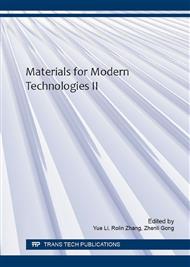p.79
p.85
p.90
p.96
p.104
p.111
p.118
p.127
p.134
Nano-Mesh Structured Mn-Based Oxide/Conducting Polymer Composite Electrode for Supercapacitor
Abstract:
In this work, modified nano-mesh structured Mn-based oxide electrode material and the supercapacitors are researched. Three types of conducting polymers, i.e. polyaniline (PANI), polypyrrole (PPy) and polythiophene (PTs) are considered to modify Mn-based oxide electrodes. The results of field emission scanning electron microscope show that conducting polymer film can form porous structure on Mn-based oxide electrode, this special structure is beneficial to the improvement of specific surface area, so that the specific capacitance can be increased. The specific capacitance of the supercapacitors assembled by Mn-based oxide/conducting polymer composite electrodes are tested, resulting that the maximum initial specific capacitance is 843 F g-1, cycle life is 105 times. Compared to supercapacitors assembled by general Mn-based oxide electrodes, this Mn-based oxide/conducting polymer material electrode can improve the specific capacitance up to 1.4~1.9 times, and the conductivity and cycle stability can be increased at the same time.
Info:
Periodical:
Pages:
104-108
Citation:
Online since:
May 2016
Authors:
Price:
Сopyright:
© 2016 Trans Tech Publications Ltd. All Rights Reserved
Share:
Citation:


